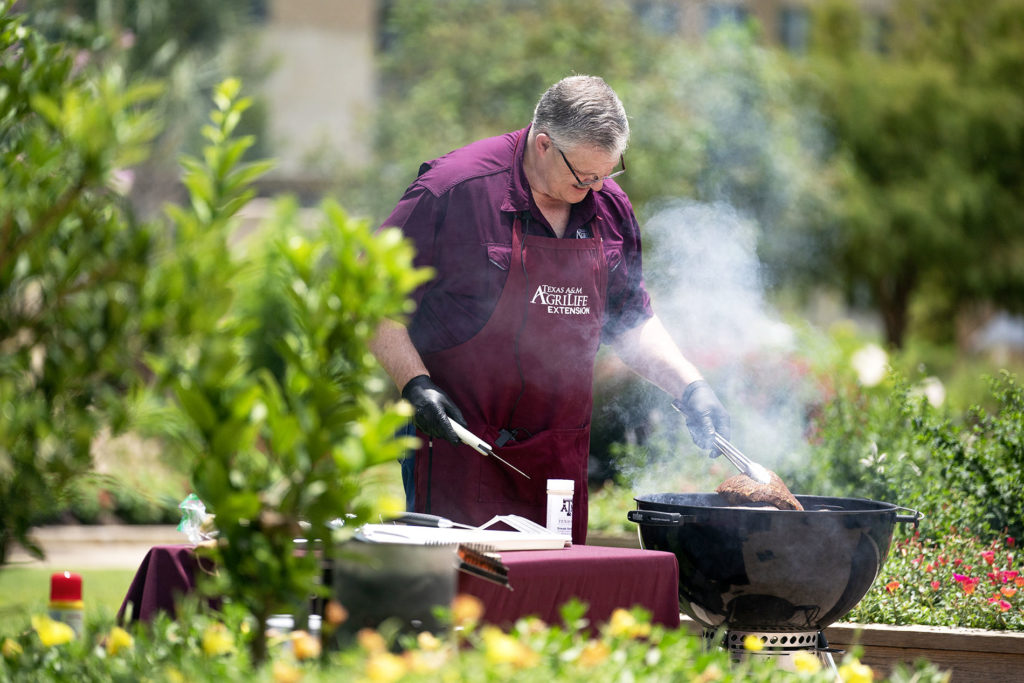Grilling like a Texan
Proper techniques can lead to better tailgating, grilling experiences
Hamburgers, rib-eyes, pork loin steaks, chicken breasts. These are only a sampling of what Texans are grilling this fall as football tailgaters are in full swing.

But are you grilling smart? Davey Griffin, Ph.D., Texas A&M AgriLife Extension Service meats specialist in the Texas A&M College of Agriculture and Life Sciences Department of Animal Science, Bryan-College Station, provided several tips on how to grill like a Texan at the recent Southeast Texas Ag Summit in Baytown.
Griffin said the best results can be had by using a meat thermometer to cook cuts at proper temperatures and regulating smoke to give meats a more flavorful eating experience. He also offers some ways to save money as retail meat prices continue an upward climb.
Controlling the smoke
Griffin uses a conventional Weber charcoal grill. He advises grillers to be mindful of regulating smoke while cooking. Rather than controlling the smoke from the top lid, he suggests using the air supply adjustment on the bottom portion of the grill.
“By doing this, you are allowing the air and smoke a continuous flow that covers the entire cooking area,” he said.
Another suggestion is to use wood chips when cooking.
“If you want more flavorful smoke, wood chips can be an excellent choice,” Griffin said. “A lot of times you see wood chips piled over one section of the charcoal. But if you put the chips in a foil wrap, then punch a few holes and place on top of the charcoal, you will get a more even flow of smoke across the meat. Some of the best barbecue comes when you have that good, clear smoke.”
Your choice of wood chips may range from oak for beef to hickory or pecan for pork or poultry, or you may want to try some of the fruit woods for a change of pace, he said.
Controlling the temperature
To cook properly, Griffin said a cooking thermometer can help gauge temperature of meat during the cook. However, it’s important to use a thermometer that is properly calibrated.
He advises placing the thermometer in an ice bath and then testing it to ensure its readings are accurate.
“When grilling, take the temperature from the side in the very center of the meat,” he said. “For pork, cook to an internal temp of 145 degrees and then let it rest for approximately three minutes.”
For beef cuts, Griffin recommends 145 degrees internal temperature and for poultry 165 degrees. Hamburger patties should also be cooked to an internal temperature of 160 degrees.
“All poultry should be cooked to 165 degrees,” he said. “They go into a chilling water system that leaves the product more likely for salmonella.”
For beef brisket, he said cook the meat to a temperature of 165 degrees, then wrap with peach paper or pink butcher paper to finish at 195-205 degrees until “when it feels tender when probing.”
Griffin said if grilling a large piece of meat, give it time to rest.
“What we mean by that is take it off the grill, set it aside and let it cool to 140-150 degrees,” he said. “If you cut too soon, you will lose all of that juice inside and the meat will dry out. Resting lets the juices equilibrate and will result in a much more favorable eating experience.”
Saving some money while grilling out
Griffin also provides some ways to save money as retail meat prices continue an upward climb. His demonstrations include cooking pork loin chops, chicken breasts, ground chuck for hamburger patties, flat iron steaks and sausage either directly or indirectly over the coals.
With popular choice retail meat prices more expensive due to demand, Griffin suggests being choosier when shopping for cuts. For example, flat iron steaks from the front shoulder of the beef carcass can provide as good an eating experience as the typical rib-eye.
“(The flat iron) is the second-most tender muscle on the carcass,” he said. “The flat iron costs around $6 (a pound) for a steak, versus $16 (a pound) for a rib-eye.”


